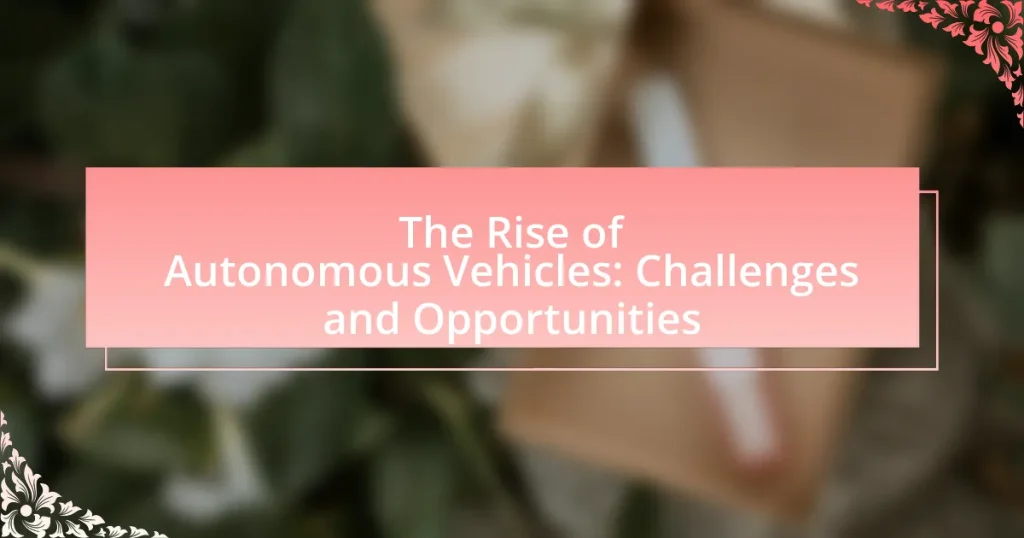Autonomous vehicles, or self-driving cars, are equipped with advanced technology that allows them to operate without human intervention, promising significant improvements in road safety, traffic congestion reduction, and enhanced mobility for individuals unable to drive. This article explores the operational mechanisms of autonomous vehicles, including the integration of sensors, artificial intelligence, and connectivity systems, while highlighting their potential benefits such as decreased accident rates and increased economic value. Additionally, it addresses the challenges faced by this technology, including regulatory hurdles, public perception issues, and ethical considerations surrounding decision-making algorithms. The article also examines future trends, innovations, and best practices for integrating autonomous vehicles into society, emphasizing the need for comprehensive frameworks to ensure safe and effective deployment.

What are Autonomous Vehicles and Their Significance?
Autonomous vehicles are self-driving cars equipped with technology that enables them to navigate and operate without human intervention. Their significance lies in their potential to enhance road safety, reduce traffic congestion, and improve mobility for individuals unable to drive, such as the elderly and disabled. According to the National Highway Traffic Safety Administration, over 94% of serious crashes are due to human error, indicating that autonomous vehicles could significantly decrease accident rates. Additionally, a study by McKinsey & Company estimates that widespread adoption of autonomous vehicles could reduce traffic congestion by up to 30%, leading to more efficient transportation systems.
How do Autonomous Vehicles operate?
Autonomous vehicles operate using a combination of sensors, software, and artificial intelligence to navigate and control the vehicle without human intervention. These vehicles utilize technologies such as LiDAR, radar, cameras, and GPS to perceive their environment, allowing them to detect obstacles, lane markings, and traffic signals. The data collected from these sensors is processed by onboard algorithms that make real-time decisions regarding acceleration, braking, and steering.
For instance, Waymo’s autonomous vehicles have been tested extensively in various urban environments, demonstrating their ability to navigate complex traffic scenarios safely. According to a report by the National Highway Traffic Safety Administration, autonomous vehicles have the potential to reduce traffic accidents significantly, as they can react faster than human drivers and eliminate errors caused by fatigue or distraction.
What technologies enable the functionality of Autonomous Vehicles?
Autonomous vehicles rely on several key technologies to function effectively, including sensors, artificial intelligence, machine learning, and connectivity systems. Sensors such as LiDAR, radar, and cameras provide real-time data about the vehicle’s surroundings, enabling it to detect obstacles, lane markings, and traffic signals. Artificial intelligence processes this data to make driving decisions, while machine learning algorithms improve the vehicle’s performance over time by learning from past experiences. Connectivity systems, including Vehicle-to-Everything (V2X) communication, allow autonomous vehicles to interact with other vehicles and infrastructure, enhancing safety and efficiency. These technologies collectively enable autonomous vehicles to navigate complex environments and operate safely without human intervention.
How do sensors and software work together in Autonomous Vehicles?
Sensors and software in autonomous vehicles collaborate to enable safe navigation and decision-making. Sensors, such as LiDAR, cameras, and radar, gather real-time data about the vehicle’s surroundings, including obstacles, road conditions, and traffic signals. This data is then processed by sophisticated software algorithms that interpret the information, allowing the vehicle to understand its environment and make informed driving decisions. For instance, a study by the National Highway Traffic Safety Administration indicates that sensor fusion, where data from multiple sensors is combined, enhances the accuracy of object detection and classification, crucial for safe autonomous driving.
What are the potential benefits of Autonomous Vehicles?
Autonomous vehicles offer several potential benefits, including increased safety, reduced traffic congestion, and enhanced mobility for individuals unable to drive. Studies indicate that autonomous vehicles could reduce traffic accidents by up to 90% due to their ability to eliminate human error, which is responsible for the majority of crashes. Furthermore, these vehicles can optimize traffic flow through advanced algorithms, potentially decreasing travel times and fuel consumption. Additionally, they provide greater accessibility for elderly and disabled individuals, allowing them to travel independently.
How can Autonomous Vehicles improve road safety?
Autonomous vehicles can improve road safety by significantly reducing human error, which is responsible for approximately 94% of traffic accidents. These vehicles utilize advanced sensors, machine learning algorithms, and real-time data processing to detect and respond to their environment more effectively than human drivers. For instance, studies have shown that the implementation of autonomous driving technology could potentially decrease traffic fatalities by up to 90% by eliminating distractions, fatigue, and impaired driving.
What economic advantages do Autonomous Vehicles offer?
Autonomous vehicles offer significant economic advantages, including reduced transportation costs and increased productivity. By eliminating the need for human drivers, companies can save on labor expenses, which can account for up to 50% of operational costs in the transportation sector. Additionally, autonomous vehicles can optimize routes and reduce fuel consumption, leading to lower operational costs. A study by the McKinsey Global Institute estimates that widespread adoption of autonomous vehicles could generate up to $1.3 trillion in economic value annually in the U.S. alone, primarily through efficiency gains and reduced accident-related costs.
What challenges do Autonomous Vehicles face?
Autonomous vehicles face significant challenges including technological limitations, regulatory hurdles, and public acceptance issues. Technological limitations encompass difficulties in accurately interpreting complex environments, such as unpredictable human behavior and adverse weather conditions, which can hinder the vehicle’s decision-making capabilities. Regulatory hurdles arise from the lack of standardized laws and guidelines governing the operation of autonomous vehicles, leading to inconsistencies across different regions. Public acceptance issues stem from concerns about safety, privacy, and the potential loss of jobs in driving-related sectors, which can impede widespread adoption. These challenges collectively impact the development and deployment of autonomous vehicles in society.
What regulatory hurdles must be overcome for Autonomous Vehicles?
Autonomous vehicles must overcome several regulatory hurdles, including the establishment of safety standards, liability frameworks, and data privacy regulations. Safety standards are crucial as they ensure that autonomous vehicles meet specific performance criteria to protect passengers and pedestrians; for instance, the National Highway Traffic Safety Administration (NHTSA) has been developing guidelines for testing and deploying these vehicles. Liability frameworks need to clarify who is responsible in the event of an accident involving an autonomous vehicle, which is essential for insurance and legal accountability. Additionally, data privacy regulations must address how the vast amounts of data collected by these vehicles are managed and protected, as highlighted by the General Data Protection Regulation (GDPR) in Europe, which sets strict guidelines for data handling. These regulatory challenges must be navigated to facilitate the safe and widespread adoption of autonomous vehicles.
How do public perceptions impact the adoption of Autonomous Vehicles?
Public perceptions significantly impact the adoption of Autonomous Vehicles (AVs) by influencing consumer trust and acceptance. Research indicates that negative perceptions, often stemming from safety concerns and lack of understanding, can hinder the willingness to adopt AV technology. For instance, a 2020 study by the American Automobile Association found that 71% of Americans were afraid to ride in a fully autonomous vehicle, highlighting the critical role of public sentiment in shaping market readiness. Additionally, positive perceptions, driven by awareness of technological advancements and potential benefits such as reduced traffic accidents and increased mobility, can enhance acceptance rates. Therefore, addressing public concerns through education and transparent communication is essential for fostering a favorable environment for AV adoption.
How do technological advancements influence Autonomous Vehicles?
Technological advancements significantly influence Autonomous Vehicles by enhancing their safety, efficiency, and functionality. Innovations such as advanced sensors, machine learning algorithms, and high-definition mapping enable vehicles to perceive their environment accurately and make real-time decisions. For instance, the integration of LiDAR technology allows for precise distance measurement and obstacle detection, which is crucial for safe navigation. According to a report by the National Highway Traffic Safety Administration, the implementation of these technologies could reduce traffic accidents by up to 90%. Furthermore, advancements in connectivity, such as Vehicle-to-Everything (V2X) communication, improve traffic management and reduce congestion, thereby increasing overall efficiency. These developments collectively drive the evolution of Autonomous Vehicles, making them more reliable and capable of operating in diverse conditions.
What role does infrastructure play in the success of Autonomous Vehicles?
Infrastructure is crucial for the success of Autonomous Vehicles (AVs) as it provides the necessary framework for safe and efficient operation. Well-designed roadways, traffic signals, and communication systems enable AVs to navigate, interpret their environment, and interact with other road users effectively. For instance, the deployment of smart traffic signals that communicate with AVs can optimize traffic flow and reduce congestion, enhancing overall safety and efficiency. Furthermore, the integration of dedicated lanes for AVs can minimize conflicts with human-driven vehicles, thereby improving operational reliability. Studies indicate that cities investing in AV-friendly infrastructure, such as dedicated lanes and enhanced signage, experience a significant reduction in accidents and improved traffic management, demonstrating the direct impact of infrastructure on the successful deployment of autonomous technology.

What are the Ethical Considerations Surrounding Autonomous Vehicles?
The ethical considerations surrounding autonomous vehicles include issues of safety, accountability, and decision-making in critical situations. Autonomous vehicles must navigate complex moral dilemmas, such as how to prioritize the safety of passengers versus pedestrians in unavoidable accident scenarios. For instance, the “trolley problem” illustrates the ethical challenge of programming vehicles to make life-and-death decisions. Additionally, accountability becomes a significant concern; determining who is responsible for accidents involving autonomous vehicles—manufacturers, software developers, or vehicle owners—remains unresolved. Furthermore, the potential for bias in algorithms used for decision-making raises ethical questions about fairness and discrimination. These considerations highlight the need for comprehensive regulatory frameworks and ethical guidelines to govern the development and deployment of autonomous vehicles.
How do Autonomous Vehicles address liability issues in accidents?
Autonomous vehicles address liability issues in accidents primarily through the implementation of insurance models that shift responsibility from drivers to manufacturers and software developers. This shift is based on the understanding that the technology controlling the vehicle is responsible for its operation, thus making manufacturers liable for accidents caused by software malfunctions or design flaws. For instance, in 2020, the National Highway Traffic Safety Administration (NHTSA) indicated that liability could rest with the manufacturer if the vehicle’s automated systems were found to be at fault, as seen in cases involving Tesla’s Autopilot feature. This evolving legal framework aims to clarify accountability and ensure that victims can seek compensation from those who design and produce the technology, rather than from individual drivers who may not have control over the vehicle’s actions.
What ethical dilemmas arise from decision-making algorithms in Autonomous Vehicles?
Decision-making algorithms in Autonomous Vehicles present ethical dilemmas primarily related to safety, accountability, and moral decision-making. These algorithms must make split-second decisions in scenarios where harm is unavoidable, raising questions about how to prioritize the safety of passengers versus pedestrians. For instance, in a situation where a collision is imminent, should the algorithm prioritize the lives of its occupants or minimize overall harm, potentially sacrificing its passengers to save others? This dilemma is often illustrated by the “trolley problem,” which poses moral questions about the value of lives in critical situations. Furthermore, accountability issues arise when accidents occur; it is unclear whether liability falls on the vehicle manufacturer, software developers, or the vehicle owner. Research by the MIT Media Lab highlights that public opinion varies significantly on these ethical decisions, indicating a lack of consensus on acceptable algorithmic behavior. Thus, the ethical dilemmas surrounding decision-making algorithms in Autonomous Vehicles are complex and multifaceted, involving critical considerations of safety, accountability, and societal values.
How can transparency in Autonomous Vehicle technology be ensured?
Transparency in Autonomous Vehicle technology can be ensured through the implementation of standardized data-sharing protocols and open-source algorithms. Standardized protocols allow for consistent communication of vehicle performance data, enabling stakeholders to access and understand how decisions are made. Open-source algorithms promote scrutiny and collaboration, allowing researchers and developers to analyze and improve the technology. For instance, the IEEE P2846 standard aims to establish guidelines for data transparency in automated driving systems, ensuring that manufacturers disclose critical information about their algorithms and decision-making processes. This approach fosters trust and accountability in the technology, ultimately enhancing public confidence in autonomous vehicles.
What impact do Autonomous Vehicles have on employment?
Autonomous vehicles significantly impact employment by potentially displacing jobs in driving-related sectors while also creating new opportunities in technology and vehicle maintenance. The introduction of self-driving technology threatens approximately 3.5 million driving jobs in the United States, according to a report by the Center for Global Policy Solutions. However, the rise of autonomous vehicles also leads to job creation in areas such as software development, data analysis, and vehicle servicing, as the industry adapts to new technologies. This dual effect highlights the need for workforce retraining and adaptation to mitigate job losses while capitalizing on emerging roles in the evolving transportation landscape.
Which jobs are most at risk due to the rise of Autonomous Vehicles?
The jobs most at risk due to the rise of Autonomous Vehicles include truck drivers, taxi drivers, and delivery personnel. These occupations are primarily focused on driving tasks that can be automated through advancements in autonomous technology. According to a report by the McKinsey Global Institute, up to 15% of the global workforce, or around 400 million workers, could be displaced by automation by 2030, with driving-related jobs being among the most vulnerable. This data highlights the significant impact that autonomous vehicles could have on employment in these sectors.
How can workforce transition be managed in the era of Autonomous Vehicles?
Workforce transition in the era of Autonomous Vehicles can be managed through targeted retraining programs and strategic workforce planning. Companies and governments should implement comprehensive training initiatives that focus on upskilling workers in technology, data analysis, and vehicle maintenance, as these skills will be essential in a landscape dominated by automation. For instance, the World Economic Forum’s “Future of Jobs Report 2020” indicates that by 2025, 85 million jobs may be displaced, but 97 million new roles could emerge, emphasizing the need for proactive workforce development. Additionally, collaboration between industry stakeholders, educational institutions, and policymakers can facilitate smoother transitions by aligning training programs with future job market demands.

What Future Trends Can We Expect for Autonomous Vehicles?
Future trends for autonomous vehicles include increased integration of artificial intelligence, enhanced safety features, and widespread adoption of electric vehicle technology. The integration of AI will enable vehicles to learn from their environments and improve decision-making processes, leading to safer and more efficient driving experiences. Enhanced safety features, such as advanced sensor systems and real-time data analysis, are expected to reduce accidents significantly; for instance, a study by the National Highway Traffic Safety Administration indicates that 94% of serious crashes are due to human error, which autonomous systems aim to mitigate. Additionally, the shift towards electric vehicles aligns with global sustainability goals, as governments and manufacturers prioritize reducing carbon emissions, with projections indicating that by 2030, 30% of all vehicles sold will be electric.
How will Autonomous Vehicles evolve in the next decade?
Autonomous vehicles will evolve significantly in the next decade through advancements in artificial intelligence, improved sensor technologies, and regulatory frameworks. These vehicles will increasingly integrate machine learning algorithms that enhance decision-making capabilities, allowing for safer navigation in complex environments. For instance, companies like Waymo and Tesla are already testing Level 4 and Level 5 automation, which indicates a shift towards fully autonomous systems capable of operating without human intervention in most scenarios.
Moreover, the development of high-definition mapping and LiDAR technology will improve the accuracy of vehicle perception, enabling better obstacle detection and response times. According to a report by McKinsey & Company, the autonomous vehicle market could reach $1.5 trillion by 2030, driven by these technological advancements and growing consumer acceptance. Additionally, regulatory bodies are beginning to establish guidelines that will facilitate the deployment of autonomous vehicles, ensuring safety and public trust. This combination of technology and regulation will likely lead to widespread adoption and integration of autonomous vehicles into everyday transportation systems.
What innovations are on the horizon for Autonomous Vehicle technology?
Innovations on the horizon for Autonomous Vehicle technology include advancements in artificial intelligence, improved sensor technologies, and enhanced vehicle-to-everything (V2X) communication systems. These developments aim to increase safety, efficiency, and reliability in autonomous driving. For instance, AI algorithms are becoming more sophisticated, enabling vehicles to better interpret complex environments and make real-time decisions. Additionally, sensor technologies, such as LiDAR and radar, are evolving to provide higher resolution data, which enhances obstacle detection and navigation capabilities. Furthermore, V2X communication allows vehicles to interact with infrastructure and other road users, facilitating smoother traffic flow and reducing accidents. These innovations are supported by ongoing research and investment from major automotive manufacturers and tech companies, indicating a strong trajectory toward fully autonomous systems.
How might consumer behavior change with the rise of Autonomous Vehicles?
Consumer behavior is likely to shift significantly with the rise of Autonomous Vehicles (AVs), as individuals may prioritize convenience and safety over traditional ownership models. Research indicates that consumers may increasingly favor ride-sharing and mobility-as-a-service options, reducing the demand for personal vehicle ownership. A study by the Boston Consulting Group found that by 2030, up to 30% of miles driven in urban areas could be in shared autonomous vehicles, reflecting a change in consumer preferences towards shared mobility solutions. Additionally, the perception of safety associated with AV technology could lead to increased trust in automated transport, further influencing consumer choices.
What are the best practices for integrating Autonomous Vehicles into society?
The best practices for integrating Autonomous Vehicles (AVs) into society include establishing comprehensive regulatory frameworks, promoting public awareness and education, and ensuring robust infrastructure development. Comprehensive regulatory frameworks are essential to address safety, liability, and operational standards, as seen in the guidelines set by the National Highway Traffic Safety Administration (NHTSA) in the United States, which emphasize safety and accountability. Promoting public awareness and education helps build trust and acceptance among the public, as studies indicate that informed communities are more likely to embrace AV technology. Additionally, developing robust infrastructure, such as dedicated lanes and smart traffic signals, is crucial for the effective operation of AVs, as demonstrated by pilot programs in cities like San Francisco and Phoenix, which have shown improved traffic flow and safety outcomes.


